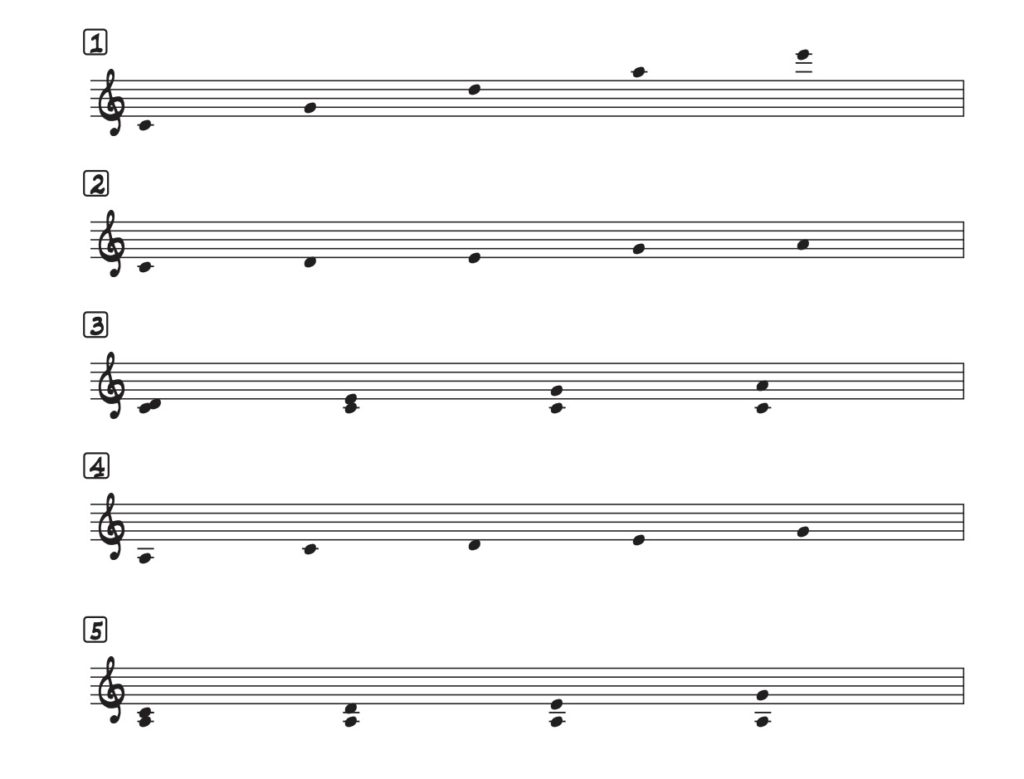
Dorian or Mixolydian? An ambiguous, bluesy quality
“Asteroid B612″¹ is, for the most part, a modal composition built around a two-bar ostinato (cf. sheet music² above). Its harmony is quite mysterious, and I have in fact been trying to wrap my mind around it for years³. There is indeed a sense of two distinct, overlapping tonics: the F (on every downbeat in the piano’s left hand) against the prominent Bb in the bass line. I chose to write the composition in the key of F minor, because the Db (minor sixth, implying F natural minor/Aeolian) appears often. But the note D (the major sixth, which would transform the F minor scale into an F Dorian mode) is also present (see end of measures 1 and 3). The D’s appearance alongside the Db gives the pattern a bluesy feel, and thus hints at the fact that Bb is probably the right choice for a stable tonic here (because Bb sits a minor third below Db and a major third below D, and the ambiguity of the minor/major third is characteristic of blues harmony).
Assuming that Bb is indeed our tonic leaves us with two options: Bb Dorian (equivalent to F natural minor/Aeolian) or Bb Mixolydian (equivalent to F Dorian).
Let’s summarize these findings in a simple table:
| F natural minor/Aeolian <=> Bb Dorian | Bb C Db Eb F G Ab Bb |
| F Dorian <=> Bb Mixolydian | Bb C D Eb F G Ab Bb |
Dorian and Mixolydian: the bebop dominant scale and the I7/IV7 chords (tertial harmony)
Looking at the totality of the pitches present in the ostinato (cf. the sheet music at the top of this post), we have the following notes in chronological order of appearance (reading from bottom to top, i.e. bass first, then piano left hand, and finally right hand):
| Bb | F | Eb | G | C | Db | Ab | D |
All we really need to look at here is measure 1 in order to get these eight pitches. The same result can also simply be obtained by combining the pitches from the Bb Dorian and Bb Mixolydian modes: Bb C [ Db + D ] Eb F G Ab. Now, by shifting our tonic from Bb to Eb, we can rearrange these pitches into an Eb bebop dominant scale:
| Eb | D | Db | C | Bb | Ab | G | F | (Eb) |
| Eb | Db | Bb | G | (Eb) | ||||
| D | C | Ab | F |
Notice that by playing and skipping every other note, descending from the high Eb, the Eb7 chord is formed (Eb D Db C Bb Ab G F, chord tones 1, 3, 5, b7 in bold). Alternatively, playing/skipping every other note descending from the note D as your starting pitch will yield a Bb7 rootless voicing (D Db C Bb Ab G F Eb, chord tones 3, 5, b7 and tension 9). These are the I and IV chords characteristic of blues harmony.
Lydian scales, major pentatonics, and the sus4 chord (quartal/quintal harmony)
The group of eight pitches presented in Table 2 can also be seen as two distinct Lydian scales: Db Lydian (Db Eb F G Ab Bb C) and Ab Lydian (Ab Bb C D Eb F G). Just like George Russell in his Lydian Chromatic Concept of Tonal Organization, let’s reorganize our pitches as perfect fifths stacked on top of each other:
| Db | Ab | Eb | Bb | F | C | G | |
| Ab | Eb | Bb | F | C | G | D |
From these Lydian scales, the following four major pentatonics can be derived: Db, Ab, Eb, and Bb.
| Db | Ab | Eb | Bb | F | |||
| Ab | Eb | Bb | F | C | |||
| Eb | Bb | F | C | G | |||
| Bb | F | C | G | D |
As you can see above (Tables 4 and 5), the Db and D pitches, the ones responsible for the bluesy harmonic tension we’ve been discussing all along, are at the extremities of the ladder of fifths. The remaining six “stable” pitches in between form an almost complete (without any kind of third) Bb13sus4 sound (chord tones 1, 4, 5, b7 and tensions 9, 13).
Dominant pentatonics, a middle course?
Finally, two more anhemitonic (not containing any semitones) five-note scales can be derived from the seven-note Lydian parents outlined in Table 4: the Eb and Bb dominant pentatonic scales (Eb F G Bb Db and Bb C D F Ab respectively).
| Db | Eb | Bb | F | G | |||
| Ab | Bb | F | C | D |
To me, these sound like they have an angular quality characteristic of pentatonics on the one hand (due to their intervallic content featuring major seconds and minor thirds), as well as a tertial flavour on the other. Indeed, when reordering the pitches in ladders of thirds, we fall back on our Eb and Bb dominant chords with ninths (Eb G Bb Db F and Bb D F Ab C), the very same chords we derived from the bebop dominant scale earlier (Table 3)…
Notes
¹ Recorded with Tomoko Omura (violin), Chris Jennings (double bass), and Akiko Horii (percussion) on New Dream, an album I published in late 2024.
² The sheet music presented here is an excerpt reflecting the composition’s main groove/ostinato. Full sheet music (including individual parts for violin, piano, and bass) for “Asteroid B612” is available here at Sheet Music Plus.
³ The main idea for Asteroid probably dates back to the 1990s… In fact, the tune’s ostinato and main theme are representative of some of my earliest attempts at jazz composition!
References
Funnell, Jim. New Dream. Funnelljazz FNLJZ 4. 2024.
Russell, George. Lydian Chromatic Concept of Tonal Organization – Volume One: The Art and Science of Tonal Gravity. Brookline: Concept Publishing Company, 2001.


